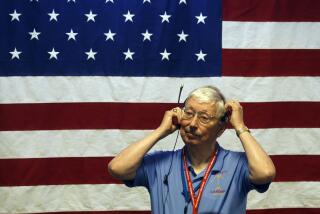Engineer helped to guide NASA
- Share via
Robert C. Seamans Jr., a leading U.S. scientist-administrator during the space race of the 1960s and secretary of the Air Force during the Vietnam War, died June 28 at his home in Beverly Farms, Mass., after a heart attack. He was 89.
Seamans was an early authority on guidance and flight controls for missiles and spacecraft and held top managerial positions in academia, industry and government. He rose to national prominence in the mid-1960s as NASA’s deputy administrator -- the No. 2 position -- and championed the call for manned space flight.
In 1969, he was selected as the ninth secretary of the Air Force. During his four-year tenure, he was credited with overseeing a modernization effort toward weapons systems -- a job complicated by budget tightening as the United States was winding down its Vietnam War engagement.
Seamans made news by publicly denying knowledge of the U.S. secret bombing campaign against Cambodia in 1969 and 1970. He also said he was informed of a massive bombing offensive unleashed in late 1971 against the North Vietnamese “when I heard it on ‘The Today Show.’ ”
Of the attack against North Vietnam, he said he was “not in the operational chain of command” because of a Defense Department reorganization. When asked for his view of the war’s toll in civilian casualties, he said: “War itself is immoral. I have to face life the way it is right at this moment.
“The North Vietnamese have been pulling stuff for a long, long time -- abducting Meo tribesmen in Laos and assassinating people in South Vietnam. . . . I’d like to have the whole thing stopped. But none of the alternatives toward reaching that objective seem to be 100% attractive.”
Robert Channing Seamans Jr. was born Oct. 30, 1918, in Salem, Mass. Engineering began to intrigue him after he learned about his great-great-grandfather, Otis Tufts, inventor of the closed-car elevator and the steam-powered printing press.
Seamans was a 1939 engineering graduate of Harvard University. He received a master’s in aeronautics from MIT in 1942 and a doctorate in instrumentation (guidance equipment) there in 1951.
Through the 1950s, Seamans taught aeronautical engineering at MIT. He was also chief engineer of a Navy guided missile project and entered private industry as chief engineer of RCA divisions overseeing missile electronics and controls. He also began a long career as a scientific advisor to NASA and the Air Force.
In 1960, he was named NASA associate administrator, with responsibilities for major policy decisions as well as daily management of research and development matters. In addition to overseeing thousands of industrial contracts, he also worked to deepen a relationship between the space agency and the Defense Department.
Five years later, Seamans became NASA deputy administrator. During the next three years, he worked to commit physicists and others in the space community to the concept of manned space flight and a lunar landing.
After stepping down as secretary of the Air Force, Seamans spent nearly 18 months as president of the National Academy of Engineering and in 1974 became the first administrator of the new Energy Research and Development Administration.
From 1978 until his retirement in 1984, Seamans was dean of MIT’s engineering school. He continued for many years to teach and lecture and served on corporate boards in the aerospace field.
“The most important impact that the continued exploration of space will have upon man will be upon his own philosophy,” he said in 1965. “That is, his view of himself in relation to the universe as he imagines it.
“The technological achievement known as the telescope brought Kepler and Galileo together in what appeared to be an attack on an established religion; but man’s faith itself did not diminish.”
He wrote a memoir, “Aiming at Targets,” originally published in 1996.
Survivors include his wife of 66 years, Eugenia Merrill Seamans; five children, Katharine Padulo of Philadelphia, Robert C. Seamans III of Beverly Farms, Mass., Joseph Seamans of Pittsburgh, May Baldwin of Cambridge, Mass., and Daniel Seamans of Berkeley; a brother; 11 grandchildren; and two great-grandchildren.
More to Read
Sign up for Essential California
The most important California stories and recommendations in your inbox every morning.
You may occasionally receive promotional content from the Los Angeles Times.










